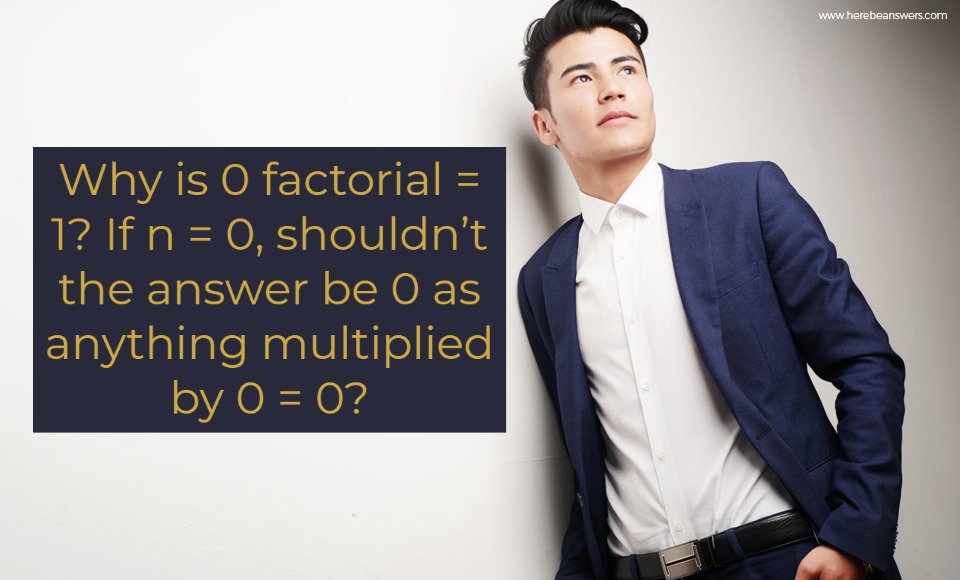Let’s exercise our brain cells!
The factorial of 5 is 120, while for 6, it’s 720. Meanwhile, the factorial for 8 is 40320, and for 10, it is 3628800. But what’s the factorial of 0? Is it 1? Or is it 0? If n is equal to zero, must it not be that the answer should zero because anything multiplied to zero would then yield zero?
Before the answer to 0 factorial or “0!” is discussed, it’s first essential to understand what are factorials. Factorial is a function that acts as an instruction to multiply all whole numbers from the chosen number down to 1. To express a factorial, an exclamation point is placed after the number. For example, if someone was to solve four factorial (also written as 4! Or 4 factorial), then all that’s needed is to multiply 4 down to 1. That means four factorial is equaled to 4 multiplied by 3, then multiplied by 2, then finally multiplied by 1. So, the answer is 24. (click here for more details)
To better understand the value of a factorial, it is expressed through this equation: n! = n × (n−1)! Which means “the factorial of any number is the number times the factorial of (the number minus 1)”. Factorials are usually found when solving for combinations and permutations. They can also be utilized in many other areas of mathematics, such as algebra and mathematical analysis. These were found to be first used in the 12th century by Indian Scholars. Fabian Stedman from 1677 described factorials to when many tuned bells are rung and the change in ringing.
Biggs, Norman L. (May 1979). “The roots of combinatorics” and Stedman, Fabian (1677), Campanalogia, London
Back to the question, to put matters simply, let us consider once again four factorial and divide it by 4,3,2,1 and then 0. Four factorial is 24. 24 divided by 4 is 6, which is 3 factorial. 6 divided by 3 is 2, which is 2 factorial. 2 divided by 2 is 1, which is 1 factorial and 1 divided by 1 is 1, which leaves us to 0 factorial.
Still, confusing? For concrete understanding, you must remember that an application of factorials is combinations and permutations. Imagine assigning musical notes to a piece of paper. How many ways can the musical notes be arranged (without repeating)? For 1 piece of paper with “do,” there is the only way: “do.” For 2 pieces of paper with “do” and “re” then there are 2 ways: “do-re” and “re-do.” For 3 pieces of paper with “do,” “re,” and “mi.” There are 6 ways! Remember that factorials are used to solve for this, so 3 factorial is 6. The options are “do-re-mi”, “do-mi-re”, “mi-do-re”, “re-do-mi”, “re-mi-do” and “mi-re-do”. If there are 4 musical notes, which are “do,” “re,” “mi,” and “fa.” then there would be 24 ways to arrange these pieces of paper. However, how would this be if there are no musical notes on the papers? How can they be arranged? Since there is nothing that would make them look any different, there would be only one way to arrange the papers. Now it’s more concrete than zero factorial is equal to one!
This is just one of the many facts about factorials. Another fact that can be related to factorials is that six weeks is exactly 10 factorial (also written as ten factorial or 10!) or 3,628,800. This is because seconds in 6 weeks is equal to 60 multiplied by 60, 24, 7, and 6. To factor them out, 60 is 2 times 3 and 10 while the other 60 is 3 times 4 and 5. 24 is 8 multiplied by 3. If rearranged, 3,628,800 is equal to 2 times 3, 4, 5, 6, 7, 8, 3, 3 and 10. The extra two 3’s equate to 9. Thus, 3,628,800 is equal to 2 times 3, 4, 5, 6, 7, 8, 9 and 10 or 10 factorial.
Additionally, there are 52 factorial ways to shuffle a deck of cards and about 60 factorial atoms in the Universe that is within our reach for observation. There are many exciting things about factorial that even zero factorial has a value!
